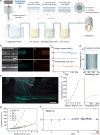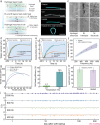Self-healing actuatable electroluminescent fibres
- PMID: 39627213
- PMCID: PMC11615400
- DOI: 10.1038/s41467-024-53955-2
Self-healing actuatable electroluminescent fibres
Abstract
Alternating-current electroluminescent fibres are promising candidates as light sources for smart textiles and soft machines. However, physical damage from daily use causes device deterioration or failure, making self-healable electroluminescent fibres attractive. In addition, soft robots could benefit from light-emitting combined with magnetically actuated functions. Here, we present a self-healing and actuatable Scalable Hydrogel-clad Ionotronic Nickel-core Electroluminescent (SHINE) fibre which achieves a record luminance of 1068 cd × m-2 at 5.7 V × μm-1. The SHINE fibre can self-heal across all constituent layers after being severed, recovering 98.6% of pristine luminance and maintaining for over 10 months. SHINE fibre is also magnetically actuatable due to the ferromagnetic nickel electrode core, enabling a soft robotic fibre with omnidirectional actuation and electro-luminescence. Our approach to this multifunctional fibre broadens the design of fibre electronics and fibre robots, with applications in interactive displays and damage-resilient navigation.
© 2024. The Author(s).
Conflict of interest statement
Competing interests: The authors declare no competing interests.
Figures




References
Grants and funding
LinkOut - more resources
Full Text Sources

